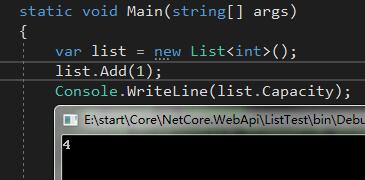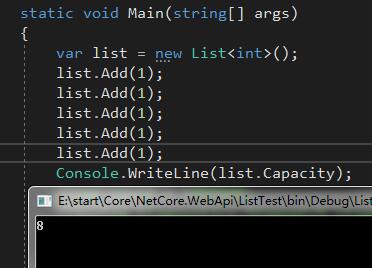深入探讨List<>中的一个姿势。
距离上一篇博文,差不多两年了。终于憋出来了一篇。[手动滑稽]
List<>是c#中很常见的一种集合形式,近期在阅读c#源码时,发现了一个很有意思的定义:
[DebuggerTypeProxy(typeof(Mscorlib_CollectionDebugView<>))]
[DebuggerDisplay("Count = {Count}")]
[Serializable]
public class List<T> : IList<T>, System.Collections.IList, IReadOnlyList<T>
{
private const int _defaultCapacity = 4;
private T[] _items;
[ContractPublicPropertyName("Count")]
private int _size;
private int _version;
[NonSerialized]
private Object _syncRoot;
static readonly T[] _emptyArray = new T[0];
// Constructs a List. The list is initially empty and has a capacity
// of zero. Upon adding the first element to the list the capacity is
// increased to 16, and then increased in multiples of two as required.
public List() {
_items = _emptyArray;
}
}
...
...
...
private void EnsureCapacity(int min) {
if (_items.Length < min) {
int newCapacity = _items.Length == 0? _defaultCapacity : _items.Length * 2;
if ((uint)newCapacity > Array.MaxArrayLength) newCapacity = Array.MaxArrayLength;
if (newCapacity < min) newCapacity = min;
Capacity = newCapacity;
}
}
咦,_defaultCapacity = 4, _items.Length * 2。抱着怀疑的态度,有了以下这一篇文章。
defaultCapacity=4?
带着怀疑的态度,我们新建一个Console程序,Debug一下。
var list = new List<int>();
Console.WriteLine(list.Capacity);
运行结果:
图片:
...怎么是0呢?一定是我打开的姿势不对,再看一下源码。发现:
static readonly T[] _emptyArray = new T[0];
...
...
public List() {
_items = _emptyArray;
}
哦,这就对了,初始化时候当然是0。那这个_defaultCapacity有何用?继续看源码。
if (_items.Length < min) {
int newCapacity = _items.Length == 0? _defaultCapacity : _items.Length * 2;
发现这个三元表达式,为什么要这样做呢?翻了一下google,发现了这样一段文字:
List实例化一个List对象时,Framework只是在内存中申请了一块内存存放List对象本身,系统此时并不知道List会有多少个item元素及元素本身大小。当List添加了第一个item时,List会申请能存储4个item元素的存储空间,此时Capacity是4,当我们添加第五个item时,此时的Capacity就会变成8。也就是当List发现元素的总数大于Capacity数量时,会主动申请且重新分配内存,每次申请的内存数量是之前item数量的两倍。然后将之前所有的item元素复制到新内存。
上面的测试,Capacity=0已经证明了上述这段话的
List实例化一个List对象时,Framework只是在内存中申请了一块内存存放List对象本身,系统此时并不知道List会有多少个item元素及元素本身大小。
接下来我们证明
当List添加了第一个item时,List会申请能存储4个item元素的存储空间,此时Capacity是4
图片:
RT,接下来,我们证明
我们添加第五个item时,此时的Capacity就会变成8。
图片:
RT,的确是这样。
那是否我们得出一个结论,因为不定长的List在Add的时候,频繁的重新申请、分配内存、复制到新内存,效率是否还可以再提升一下呢?
我们先试一下
for (int i = 0; i < count; i++)
{
var listA = new List<int>(10);
listA.Add(i);
}
| 循环次数 | 定长长度 | 运行时间 |
|---|---|---|
| 100 | 0 | 144 |
| 100 | 5 | 23 |
| 100 | 6 | 49 |
| 100 | 7 | 45 |
| 100 | 8 | 73 |
| 100 | 9 | 21 |
| 100 | 10 | 22 |
运行结果:注定长为0表示未设置List长度
| 循环次数 | 定长长度 | 运行时间 |
|---|---|---|
| 10000 | 0 | 3741 |
| 10000 | 5 | 3934 |
| 10000 | 6 | 4258 |
| 10000 | 7 | 4013 |
| 10000 | 8 | 4830 |
| 10000 | 9 | 4159 |
| 10000 | 10 | 2370 |
好吃鲸...为啥9和10差距这么多。。。
我们加大循环次数。结果:
| 循环次数 | 定长长度 | 运行时间 |
|---|---|---|
| 1000000 | 0 | 317590 |
| 1000000 | 5 | 263378 |
| 1000000 | 6 | 150444 |
| 1000000 | 7 | 157317 |
| 1000000 | 8 | 139041 |
| 1000000 | 9 | 124714 |
| 1000000 | 10 | 120547 |
随着循环次数、定长的增加,可以看出,频繁的重新申请、分配内存、复制到新内存,是很耗费时间和性能的。
在以后的工作中,如果有频繁的List.Add,特别是循环Add,不妨考虑一下给List设置一个定长。
地 址:http://www.cnblogs.com/YamatAmain/
本文版权归作者和博客园共有,欢迎转载,但未经作者同意必须保留此段声明,且在文章页面明显位置给出原文连接,否则保留追究法律责任的权利。




